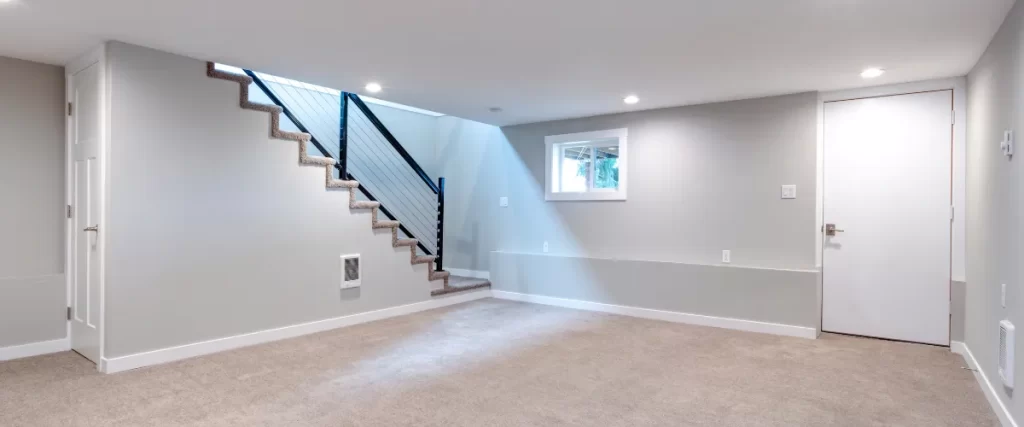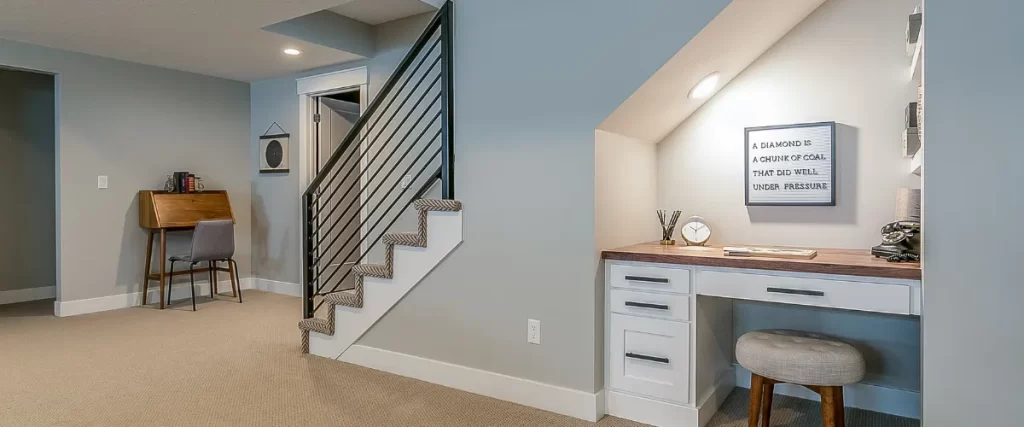Choosing the right type of basement ceiling can be confusing. One fact to know is that there are many types of basement ceilings. This article will show you options like painted ceilings, wooden planks, and drop ceilings to find what suits your space.
Keep reading to transform your basement.
Key Takeaways
- Painted ceilings are a low-cost way to brighten your basement. You can paint rafters and pipes for a modern look.
- Wooden ceilings add warmth to the space. Choices include natural wooden planks or beadboard, both giving a rustic feel.
- Metal ceilings, like tin or corrugated metal panels, offer an industrial vibe. They are durable and resist mold.
- Drop ceilings hide wiring and plumbing but still allow easy access. They come in various styles, including sound-absorbing tiles.
- Decorative tile ceilings can make basements more elegant. These tiles often help with soundproofing and insulation too.

Painted Basement Ceilings
Looking to add a pop of color to your basement? Consider painted basement ceilings. Whether it’s using a single color or creating a unique design, painting rafters, pipes, and beams can transform your space with minimal cost and effort.
Painted Rafters
Painted rafters can change a basement’s look. By painting the exposed beams and rafters the same color, you create a unified appearance. This technique helps to reflect light around the room, making it seem brighter and more open.
Black paint is popular for its ability to make mechanical systems like pipes and ductwork less noticeable while maximizing light reflectance.
A coat of paint on your basement rafters can transform the space without spending too much money.
Moving on from painted rafters, let’s talk about another way to improve your basement ceiling: painting pipes and beams.
Painted Pipes and Beams
Painting pipes and beams can change an unfinished basement into a modern living space. Homeowners find this option easy and low-cost. Use light colors to make the area look bigger and brighter.
This method helps hide plumbing pipes and electrical wiring without losing access for repairs.
Choose multiple colors to match your personal style or stick with one for a clean look. This choice adds warmth and value to your home while keeping the ceiling open. It’s perfect for basements used as guest rooms or entertainment areas because it maximizes light.
Easy installation is another plus, making painted pipes and beams popular among homeowners looking for quick basement remodels.
Wooden Ceilings
Wooden ceilings bring a warm and natural feel to your basement space. Whether it’s natural wooden planks or beadboard ceilings, they add a touch of rustic charm to the room.
Natural Wooden Planks
Natural wooden planks add warmth and a rustic feel to a basement space. They are an ideal choice for homeowners looking to create a cozy atmosphere. These planks can come in various types of wood, each adding its own unique texture and color to the ceiling.
The natural wood is easy to install and offers a timeless look that complements exposed brick walls.
Installation requires basic tools and some know-how, but the end result brings character to any house.
Adding these planks also allows for flexibility in design. You can choose from light or dark woods, depending on how you want to maximize light or add depth. Plus, matching them with the right lighting fixtures enhances the entire ceiling’s appearance while maintaining that homey vibe throughout your basement.
Beadboard Ceilings
Beadboard ceilings remain a popular choice for basements due to their simple installation and classic look. Crafted from narrow wood planks with a tongue-and-groove edge, beadboard is lightweight and easy to work with.
These ceilings come in various designs, including PVC panels that offer sound blocking properties, making them ideal for concealing utilities in the basement while adding a touch of warmth to the space.
Homeowners seeking more than just ordinary drywall can consider beadboard ceilings as they are not only affordable but also provide easy access when needed. By incorporating lighter colors or natural wooden tones into these ceilings, homeowners can create a cozy and inviting atmosphere in their basement while enhancing the overall home improvement aspect.
Beadboard ceilings indeed prove to be an excellent choice for those looking to add character and charm without delving into complex renovation projects.
Metal Ceilings
Metal ceilings offer a modern and industrial look to your basement. Whether it’s tin ceilings or corrugated metal panels, they add a unique flair to the space. Ideal for homeowners seeking a sleek and contemporary design for their basements.
Tin Ceilings
Tin ceilings bring a vintage charm to basements. They are durable and resist mold and mildew, making them a practical choice. These ceilings are available in various finishes and patterns, offering homeowners versatile options to match their design preferences.
Moreover, tin ceilings can effectively conceal utilities while adding an aesthetically pleasing touch to the basement.
Decorative ceiling tiles for tin ceilings come in lightweight panels that make installation easier. Homeowners can get creative with different color options as well as embossed designs, allowing for personalization according to individual tastes.
Tin ceilings also help in sound insulation, contributing to a quieter basement environment. Overall, tin ceilings offer both style and functionality for homeowners looking to enhance their basement space.
Corrugated Metal Panels
Corrugated metal panels provide a modern and industrial aesthetic to your basement. These lightweight, durable panels are simple to install and upkeep. They are also fire-resistant, making them a secure choice for your home.
Corrugated metal panels come in a variety of colors and finishes, enabling you to personalize the appearance of your basement ceiling.
Metal ceilings are a great option for homeowners seeking a cost-effective and stylish way to complete their basements. The corrugated metal panels offer insulation against noise and temperature changes while adding an urban aesthetic to the space.
Moreover, they are moisture-resistant, preventing mold or mildew growth in damp basements – offering both functionality and style. With these advantages, corrugated metal panels can be an ideal choice for homeowners seeking practicality without compromising on aesthetics.
Drop Ceilings
Suspended ceilings, also referred to as drop ceilings, are a favored option for basement spaces. They comprise a grid system that supports lightweight ceiling tiles. This type of ceiling enables convenient access to concealed wiring and plumbing above.
It’s a great choice if you seek to maintain accessibility while hiding the less appealing aspects of your basement’s infrastructure.
Homeowners looking for more than just practicality can discover drop ceilings in various styles and designs, including acoustic tiles that absorb sound and improve insulation. These ceilings can also integrate recessed lighting fixtures for enhanced illumination.
They offer a polished and neat look to basements while delivering practical benefits such as soundproofing and temperature control.
Suspended ceilings are adaptable, cost-effective, and customizable based on individual preferences, making them a pragmatic choice for homeowners seeking both aesthetics and functionality in their basement spaces.
Decorative Tile Ceilings
Moving on from drop ceilings, homeowners often consider decorative tile ceilings as an elegant and versatile option for their basements. These lightweight tiles, such as acoustic ceiling tiles, are designed to enhance the overall look of the basement while providing a practical solution for soundproofing.
Homeowners can opt for tongue and groove edge tiles that easily interlock for quick installation or choose ceiling panels with various patterns and designs to add a touch of sophistication to the space.
Decorative tile ceilings offer flexibility in design, allowing homeowners to tailor the basement’s ambiance in line with their preferences.
When considering decorative tile ceilings, it’s important to emphasize that they improve aesthetics and also contribute to energy efficiency by providing additional insulation. Moreover, these ceiling options come in various materials like mineral fiber, PVC, or metal, catering to different budget ranges and design requirements.
With acoustic properties that help reduce noise levels within the basement environment, these tiles create a more comfortable living space – perfect for transforming bare bones into a cozy retreat.

FAQs
1. What are some popular types of basement ceilings?
Exposed basement ceilings, corrugated metal ceilings, drop ceilings and drywall or stretch ceiling installations are all common choices for basement ceiling options.
2. How does an exposed basement ceiling differ from other types?
An exposed basement ceiling leaves the infrastructure visible, offering a raw and industrial look compared to finished styles like drywall or stretch ceilings.
3. Are there unique ideas I can consider for my basement ceiling?
Yes! Corrugated metal is a creative option that adds texture and style. You could also explore various drop-ceiling installation designs for a more traditional approach.
4. How do I choose the best type of ceiling for my basement?
Consider factors such as your budget, desired aesthetic, and practicality when choosing between options like exposed basements, corrugated metal, drop ceilings or even drywall and stretch ceilings.
Conclusion
In conclusion, there are various options to consider for your basement ceiling. You can go for a modern look by painting the rafters and pipes, or choose the warmth of natural wood planks.
Metal ceilings like tin or corrugated panels also add an industrial touch. Drop ceilings provide versatility while decorative tiles elevate the aesthetics. Each type offers unique characteristics to enhance your space.
By exploring these different types, you can find the perfect fit for your basement’s style and functionality without feeling overwhelmed. Whether you prioritize a cozy atmosphere or prefer an open and spacious feel, there’s a ceiling option that will complement your vision.
Consider factors such as maintenance, insulation needs, and overall design when making your decision.
You can also get in touch today, and let’s upgrade your space!
